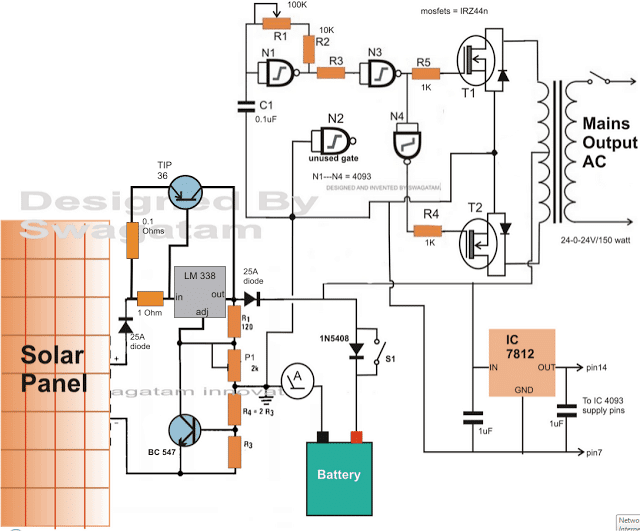In this article I will try to explain the basic concept of a solar inverter and also how to make a simple yet powerful solar inverter circuit.
Solar power is abundantly available to us and is free to use, moreover it’s an unlimited, unending natural source of energy, easily accessible to all of us.
What's so Crucial about Solar Inverters?
The fact is, there's nothing crucial about solar inverters. You can use any normal inverter circuit, hook it up with a solar panel and get the required DC to AC output from the inverter.
Having said that, you may have to select and configure the specifications correctly, otherwise you may run the risk of damaging your inverter or causing an inefficient power conversion.
Why Solar Inverter
We have already discussed how to use solar panels for generating electricity from solar or sun power, in this article we are going to discuss a simple arrangement which will enable us to use solar energy for operating our household appliances.
A solar panel is able to convert sun rays into direct current at lower potential levels. For example a solar panel may be specified for delivering 36 volts at 8 amps under optimal conditions.
However we cannot use this magnitude of power for operating our domestic appliances, because these appliances can work only at mains potentials or at voltages in the ranges of 120 to 230 V.
Further more the current should be an AC and not DC as normally received from a solar panel.
We have come across a number of inverter circuits posted in this blog and we have studied how they work.
Inverters are used for converting and stepping up low voltage battery power to high voltage AC mains levels.
Therefore inverters can be effectively used for converting the DC from a solar panel into mains outputs that would suitably power our domestic equipment.
Basically in inverters, the conversion from a low potential to a stepped up high mains level becomes feasible because of the high current that’s normally available from the DC inputs such as a battery or a solar panel. The overall wattage remains the same.
Understanding Voltage Current Specifications
For example if we supply an input of 36 volts @ 8 amps to an inverter and get an output of 220 V @ 1.2 Amps would mean that we just modified an input power of 36 × 8 = 288 watts into 220 × 1.2 = 264 watts.
Therefore we can see that it’s no magic, just modifications of the respective parameters.
If the solar panel is able to generate enough current and voltage, its output may be used for directly operating an inverter and the connected household appliances and also simultaneously for charging a battery.
The charged battery may be used for powering the loads via the inverter, during night times when solar energy is not present.
However if the solar panel is smaller in size and unable to generate sufficient power, it may be used just for charging the battery, and becomes useful for operating the inverter only after sunset.
Circuit Operation
Referring to the circuit diagram, we are able to witness a simple set up using a solar panel, an inverter and a battery.
The three units are connected through a solar regulator circuit that distributes the power to the respective units after appropriate regulations of the received power from the solar panel.
Assuming the voltage to be 36 and the current to be 10 amps from the solar panel, the inverter is selected with an input operating voltage of 24 volts @ 6 amps, providing a total power of about 120 watts.
A fraction of the solar panels amp which amounts to about 3 amps is spared for charging a battery, intended to be used after sunset.
We also assume that the solar panel is mounted over a solar tracker so that it is able to deliver the specified requirements as long as the sun is visible over the skies.
The input power of 36 volts is applied to the input of a regulator which trims it down to 24 volts.
The load connected to the output of the inverter is selected such that it does not force the inverter more than 6 amps from the solar panel. From the remaining 4 amps, 2 amps is supplied to the battery for charging it.
The remaining 2 amps are not used for the sake of maintaining better efficiency of the whole system.
The circuits are all those which have been already discussed in my blogs, we can see how these are intelligently configured to each other for implementing the required operations.
For complete tutorial please refer to this article: Solar Inverter Tutorial
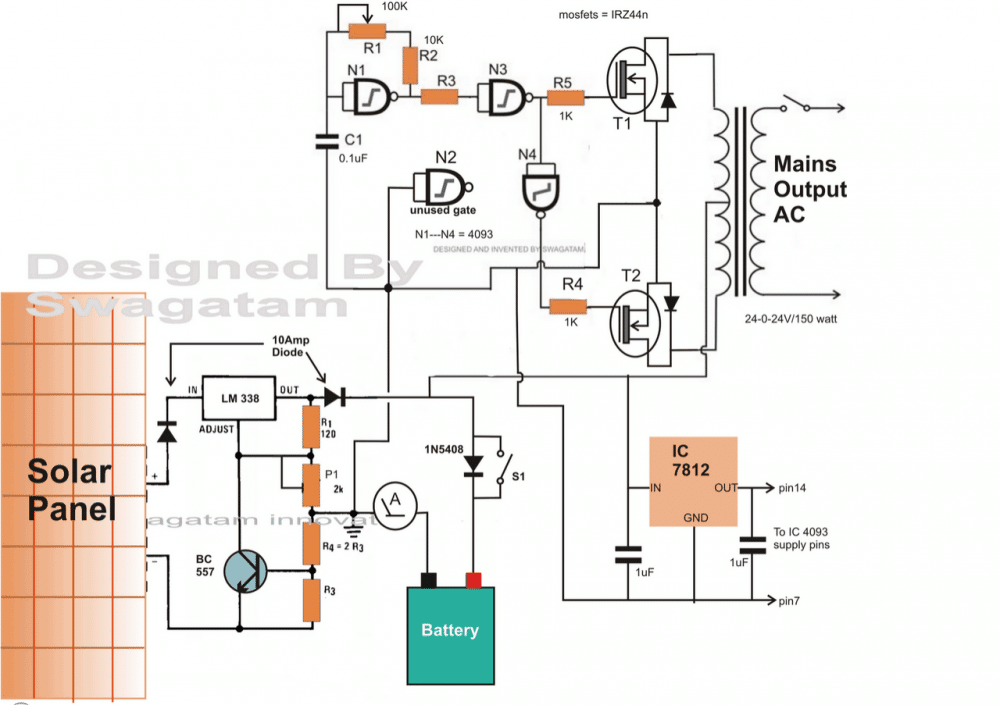
Parts List for the LM338 charger section
- All resistors are 1/4 watt 5% CFR unless specified.
- R1 = 120 ohms
- P1 = 10K pot (2K is mistkanly shown)
- R4 = replace iit with a link
- R3 = 0.6 x 10 / Battery AH
- Transistor = BC547 (not BC557, it's mistakenly shown)
- Regulator IC = LM338
- Parts List for the inverter section
- All parts are 1/4 watt unless specified
- R1 = 100k pot
- R2 = 10K
- R3 = 100K
- R4, R5 = 1K
- T1, T2 = mosfer IRF540
- N1---N4 = IC 4093
Remaining few of the parts does not need to be specified and can be copied as shown in the diagram.
For Charging Batteries up to 250 Ah
The charger section in the above circuit may be suitably upgraded for enabling the charging of high current batteries in the order of 100 AH to 250 Ah.
For 100Ah battery you can simply replace the LM338 with LM196 which is a 10 amp version of the LM338.
An outboard transistor TIP36 is appropriately integrated across the IC 338 for facilitating the required high current charging.
The emitter resistor of TIP36 must be calculated appropriately otherwise the transistor might just blow off, do it by trial and error method, start with 1 ohm initially, then gradually go on reducing it until the required amount of current becomes achievable at the output.
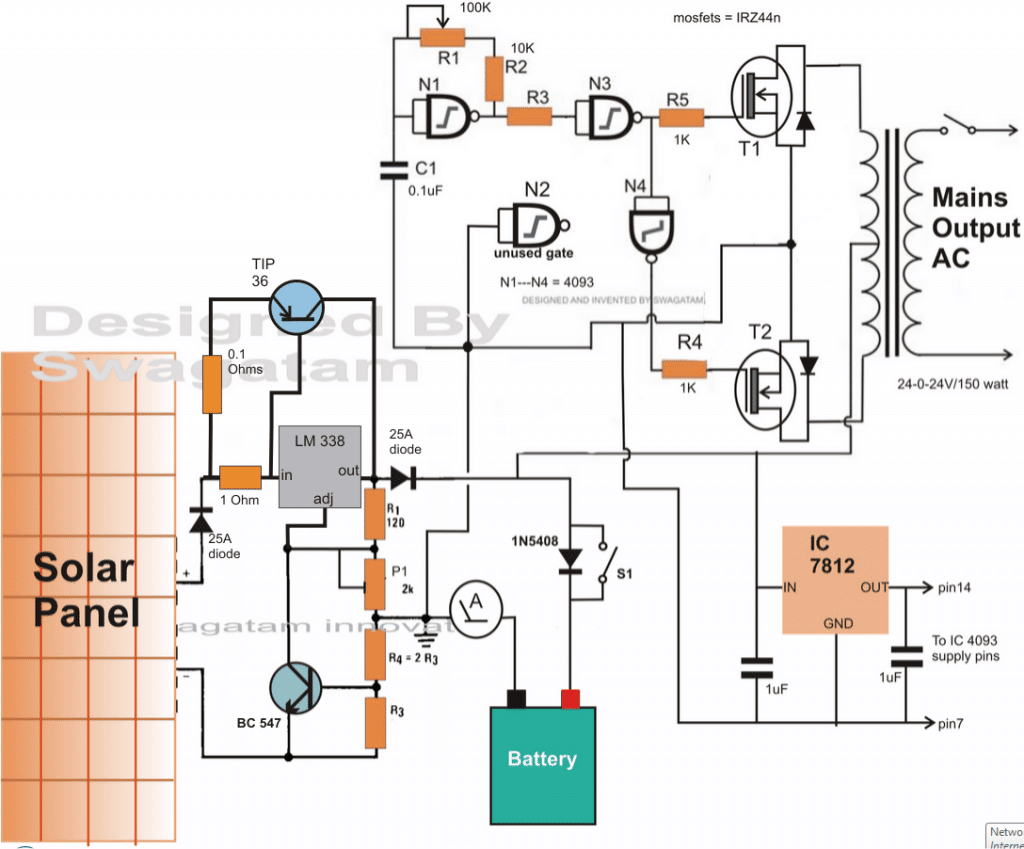
Adding a PWM Feature
For ensuring a fixed 220V or 120V output a PWM control could added to the above designs as shown in the following diagram. As can be seen the gate N1 which is basically configured as a 50 or 60Hz oscillator, is enhanced with diodes and a pot for enabling a variable duty cycle option.
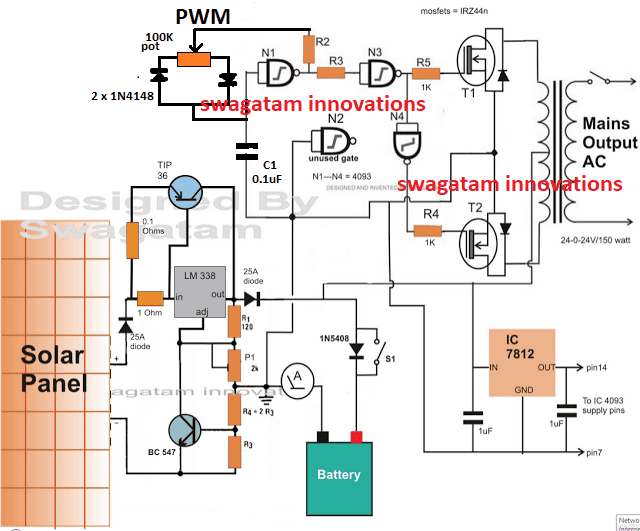
By adjusting this pot we can force the oscillator to create frequencies with different ON/OFF periods which will in turn enable the mosfets to turn ON and OFF with the the same rate.
By adjusting the mosfet ON/OFF timing we can proportionately vary the current induction in the transformer, which will eventually allow us to adjust the output RMS voltage of the inverter.
Once the output RMS is fixed, the inverter will be able to produce a constant output regardless f the solar voltage variations, until of course the voltage drops below the voltage specification of the transformer primary winding.
Solar Inverter Using IC 4047
As described earlier, you can attach any desired inverter with a solar regulator for implementing an easy solar inverter function.
The following diagram shows how a simple IC 4047 inverter can be used with the same solar regulator for getting 220 V AC or 120 V AC from the solar panel.
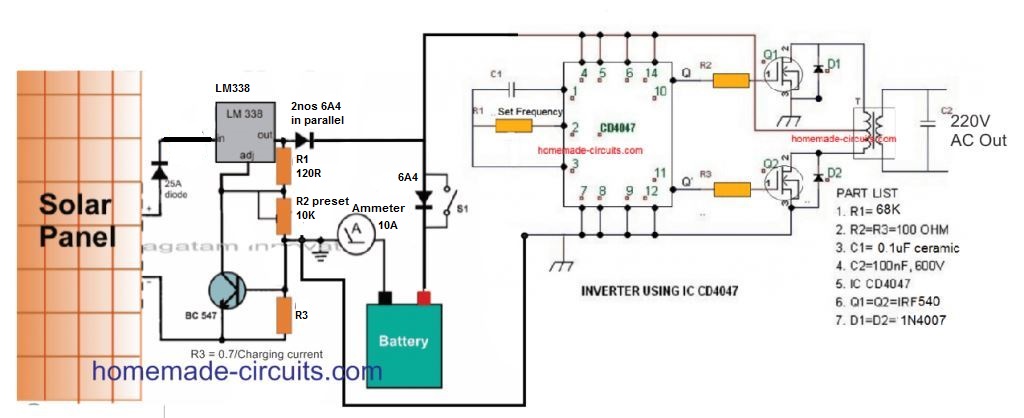
Solar Inverter using IC 555
Quite similarly if you are interested to build a small solar inverter using IC 555, you can very well do so, by integrating an IC 555 inverter with solar panel for getting the required 220V AC.
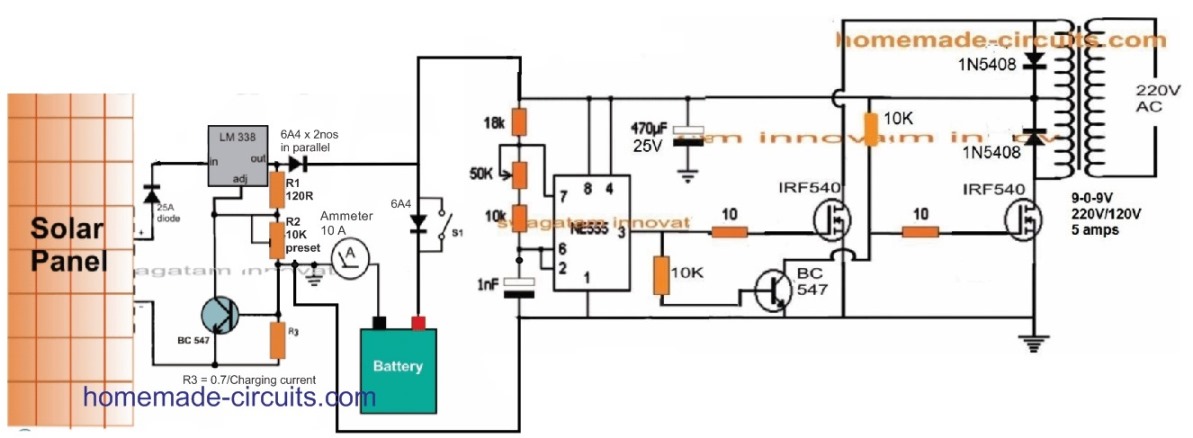
Solar Inverter using 2N3055 Transistor
The 2N3055 transistors are very popular among all electronic enthusiasts. And this amazing BJT allows you to build pretty powerful inverters with minimum number of parts.
If you are one of those enthusiasts who have a few of these devices in your junk box, and are interested to create a cool little solar inverter using them, then the the following simple design can help you to fulfill your dream.
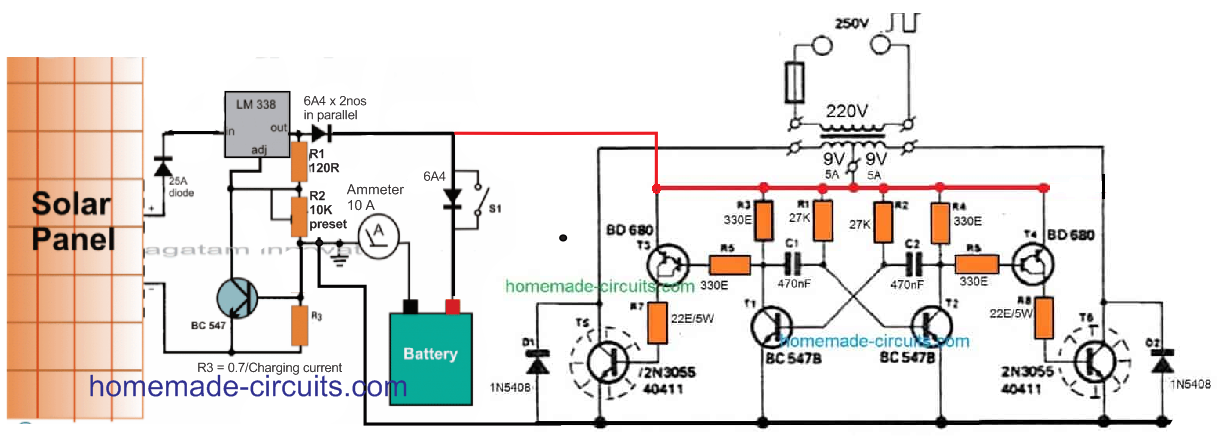
Simple Solar Inverter without a Charger Controller
For users who are not too keen on including the LM338 charger controller, for simplicity sake, the following simplest PV inverter design looks good.
Even though the battey can eb seen without a regulator, the battery will still get charged optimally, provided the solar panel gets the required adequate amount of direct sunshine.
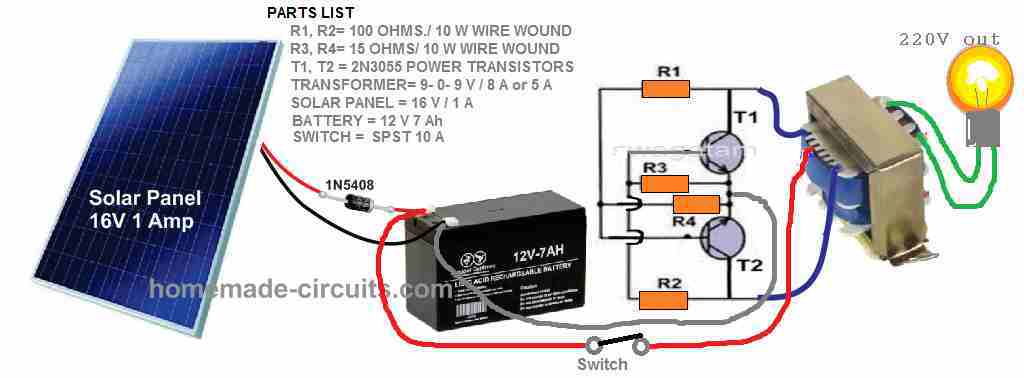
The simplicity of the design also indicates the fact that lead acid batteries are not so difficult to charge after all.
Remember, a fully discharged battery (below 11V) may require at least 8 hours to 10 hours of charging until the inverter can be switched ON for the required 12V to 220V AC conversion.
Simple Solar to AC Main Changeover
If you want your solar inverter system to have the facility of an automatic changeover from solar panel to mains grid AC, you can add the following relay modification to the LM338/LM196 regulator input:
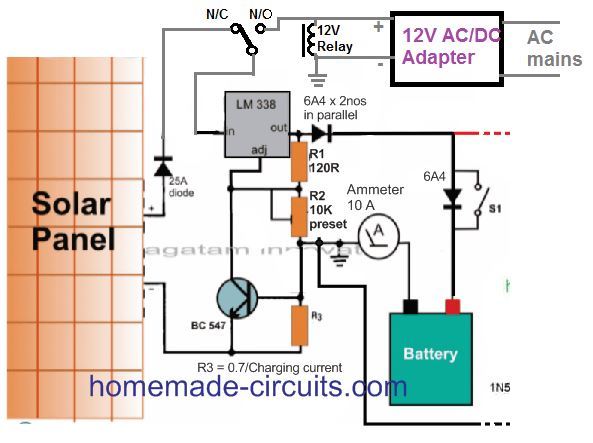
The 12V adapter should be rated to suit the battery voltage and the Ah specs. For example if the battery is rated at 12 V 50 Ah, then the 12V adapter can be rated at 15V to 20 V and 5 amp
Solar Inverter using Buck Converter
In the above discussion I have explained how to make simple solar inverter with battery charger using linear ICs like LM338, LM196, which are great when the solar panel voltage and current are same as the inverter's requirement.
In such cases the wattage of the inverter is small and restricted. For inverters loads with significantly higher wattage, the solar panel output power will also need to be large and on par with the requirements.
In this scenario, the solar panel current will need to be significantly high. But since solar panel are available with high current, low voltage making high wattage solar inverter in the order of 200 watt to 1 kva does not look easily feasible.
However, high voltage, low current solar panels are easily available. And since wattage is W = V x I, solar panels with higher voltages can easily contribute to a higher wattage solar panel.
That said, these high voltage solar panels cannot be used for low voltage, high wattage inverter applications, since the voltages may not be compatible.
For example, if we have a 60 V, 5 Amp solar panel, and a 12 V 300 watt inverter, although the wattage rating of the two counterparts may be similar, they cannot be hooked up due to voltage/current dissimilarities.
This is where a buck converter comes very handy and can be applied for converting the excess solar panel voltage to excess current, and lowering the excess voltage, as per the inverter requirements.
Making a 300 Watt Solar Inverter Circuit
Let's say we have want to make a 300 watt 12 V inverter circuit from a solar panel rated with 32 V, 15 Amps.
For this we will need an output current of 300/12 = 25 Amps from the buck converter.
The following simple buck converter from ti.com looks extremely efficient in providing the required power for our 300 watt solar inverter.
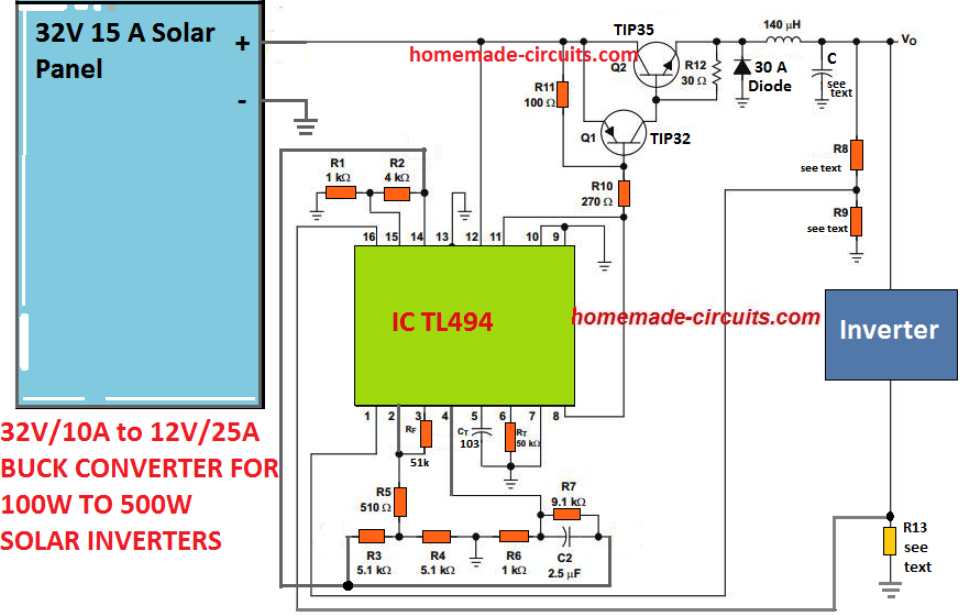
We fix the important parameters of the buck converter as given in the following calculations:
Design Requirements
• Solar Panel Voltage VI = 32 V
• Buck Converter Output VO = 12 V
• Buck Converter Output IO = 25 A
• Buck Converter Operating Frequency fOSC = 20-kHz switching frequency
• VR = 20-mV peak-to-peak (VRIPPLE)
• ΔIL = 1.5-A inductor current change
- d = duty cycle = VO/VI = 12 V/32 V = 0.375
- f = 20 kHz (design objective)
- ton = time on (S1 closed) = (1/f) × d = 7.8 μs
- toff = time off (S1 open) = (1/f) – ton = 42.2 μs
- L ≉ (VI – VO ) × ton/ΔIL
- ≉ [(32 V – 12 V) × 7.8 μs]/1.5 A
- ≉ 104 μH
This provides us the specifications of the buck converter inductor. The wire SWG can be optimized through some trial and error. A 16 SWG super enameled copper wire should be good enough to handle 25 Amps current.
Calculating the Output Filter Capacitor for the Buck Converter
After the output buck inductor is determined, the value of the output filter capacitor can be worked out to match the output ripple specifications. An electrolytic capacitor could be imagined like a series relationship of an inductance, a resistance, and a capacitance. To offer decent ripple filtering, the ripple frequency has to be much lower than the frequencies where the series inductance becomes critical.
Therefore, both the crucial elements are the capacitance and the effective series resistance (ESR). highest ESR is calculated in line with the relationship between the chosen peak-to-peak ripple voltage and the peak-to-peak ripple current.
ESR = ΔVo(ripple) / ΔIL = V/1.5 = 0.067 Ohms
The lowest C capacitance value recommended to take care of the VO ripple voltage at smaller than the 100-mV design requirement is expressed in the following calculations.
C = ΔIL / 8fΔVo = 1.5 / 8 x 20 x 103 x 0.1 V = 94 uF, although higher than this will only help to improve the output ripple response of the buck converter.
Setting up the Buck Output for the Solar Inverter
To precisely set up the output 12 V, 25 Amps we need to calculate the resistors R8, R9, and R13.
R8/R9 decides the output voltage which could be tweaked by randomly using a 10K for R8, and a 10k pot for R9. Next, adjust the 10K pot for getting the exact output voltage for the inverter.
R13 becomes the current sensing resistor for the buck converter and it ensures that the inverter is never able to draw over 25 Amp current from the panel, and is shut down in such a scenario.
Resistors R1 and R2 establish the reference of roughly 1 V for the inverting input of the TL404 internal current-limiting op amp. Resistor R13, which is connected in series with the load, delivers 1 V to the non-inverting terminal of the current-limiting error op amp as soon as the inverter current extends to 25 A. The PWM for the BJTs thus is restricted appropriately to control further intake of current. The R13 value is calculated as given under:
R13 = 1 V / 25 A = 0.04 Ohms
Wattage = 1 x 25 = 25 watts
Once the above buck converter is built and tested for the required conversion of excess panel voltage to excess output current, it's time to connect any good quality 300 watt inverter with the buck converter, with the help of the following block diagram:

Solar Inverter/Charger for Science Project
The next article below explains a simple solar inverter circuit for the newbies or school students.
Here the battery is connected directly with the panel for simplicity sake, and an automatic changeover relay system for switching the battery to the inverter in the absence of solar energy.
The circuit was requested by Ms. Swati Ojha.
The Circuit Stages
The circuit mainly consists of two stages viz: a simple inverter, and the automatic relay changeover.
During day time for so long the sun light remains reasonably strong, the panel voltage is used for charging the battery and also for powering the inverter via the relay changeover contacts.
The automatic changeover circuit preset is set such that the associated relay trips OFF when the panel voltage falls below 13 volts.
The above action disconnects the solar panel from the inverter and connects the charged battery with the inverter so that the output loads continue to run using the battery power.
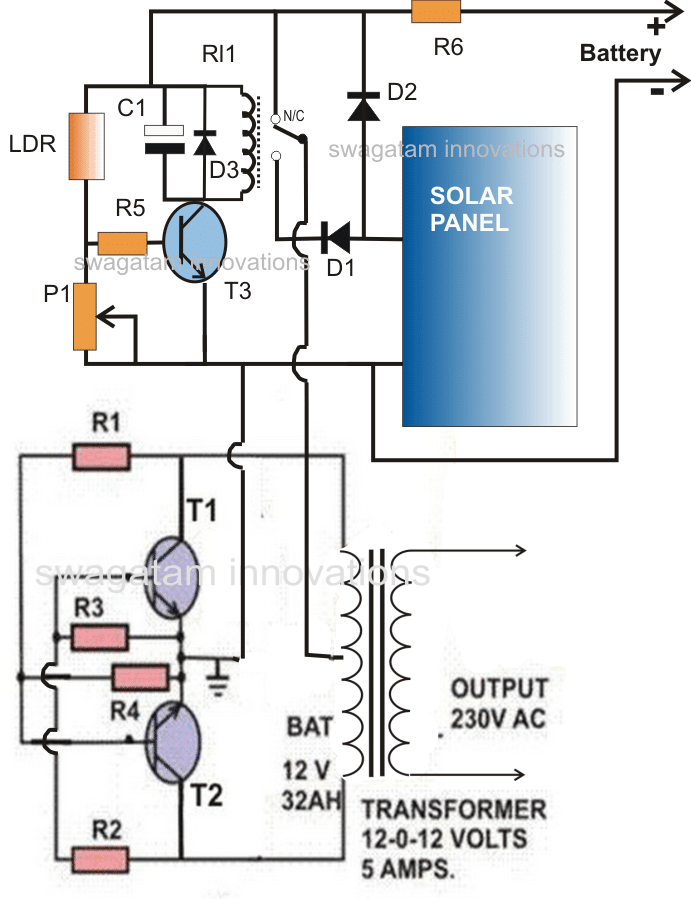
Circuit Operation:
Resistors R1, R2, R3, R4 along with T1, T2 and the transformer forms the inverter section. 12 volts applied across the center tap and the ground starts the inverter immediately, however here we do not connect the battery directly at these points, rather through a relay changeover stage.
The transistor T3 with the associated components and the relay forms the relay change over stage The LDR is kept outside the house or at a position where it can sense the day light.
The P1 preset is adjusted such that T3 just stops conducting and cuts off the relay in case the ambient light falls below a certain level, or simply when the voltage goes below 13 volts.
This obviously happens when the sun light becomes too weak and is no longer able to sustain the specified voltage levels.
However as long as sun light remains bright, the relay stays triggered, connecting the solar panel voltage directly to the inverter (transformer center tap) via the N/O contacts. Thus the inverter becomes usable through the solar panel during day time.
The solar panel is also simultaneously used for charging the battery via D2 during day time so that it charges up fully by the time it gets dusk.
The solar panel is selected such that it never generates more than 15 volts even at peak sun light levels.
The maximum power from this inverter will not be more than 60 watts.
Parts List for the proposed solar inverter with charger circuit intended for science projects.
- R1,R2 = 100 OHMS, 5 WATTS
- R3, R4 = 15 OHMS, 5 WATTS
- T1, T2 = 2N3055, MOUNTED ON SUITABLE HEATSINK
- TRANSFORMER = 9-0-9V, 3 TO 10 AMPS
- R5 = 10K
- R6 = 0.1 OHMS 1 WATT
- P1 = 100K PRESET LINEAR
- D1, D2 = 6A4
- D3 = 1N4148
- T3 = BC547
- C1 = 100uF/25V
- RELAY = 9V, SPDT
- LDR = ANY STANDARD TYPE
- SOLAR PANEL = 17 VOLTS OPEN CIRCUIT, 5 AMPS SHORT CIRCUIT CURRENT.
- BATTERY = 12 V, 25 Ah
